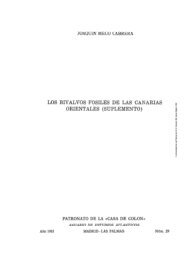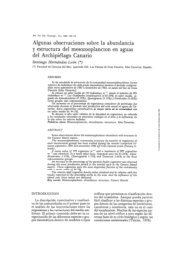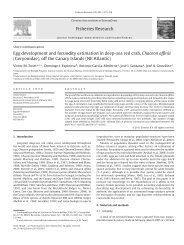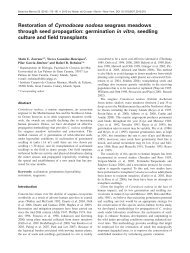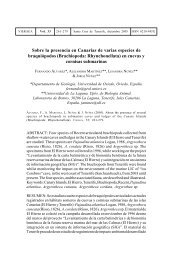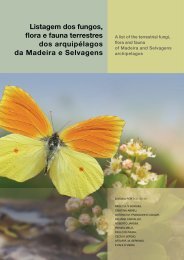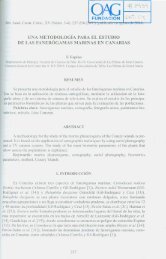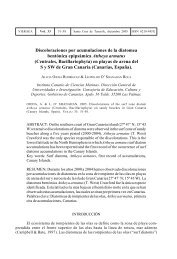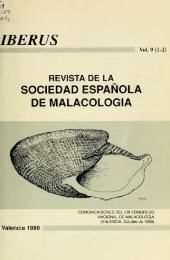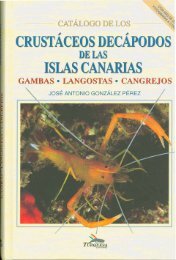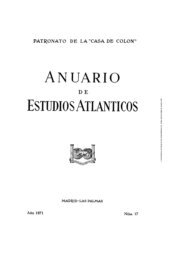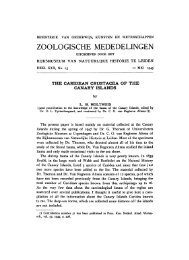A REVIEW OF GERARDIIDAE (ANTHOZOA: ZOANTHARIA ... - redmic
A REVIEW OF GERARDIIDAE (ANTHOZOA: ZOANTHARIA ... - redmic
A REVIEW OF GERARDIIDAE (ANTHOZOA: ZOANTHARIA ... - redmic
You also want an ePaper? Increase the reach of your titles
YUMPU automatically turns print PDFs into web optimized ePapers that Google loves.
Recent studies of Gerardiidae have been carried out by several auth .'<br />
Canary Islands and others Macaranesian archipelagos. These authors recorde~rs I~<br />
speCles, Gerardia savaglia (=Savalia savaglia~ from the Canaries, Madeira an a SIn<br />
Verde (see BRITO, 1983 [1] Y 1985 [2]; OCANA el al., 1995 [25]). Unfortu d ea<br />
f G 1 "· M' '" nately<br />
presence o . savag La In acaraneslan waters was a mlsldentlfication motiva '<br />
l k f d<br />
'd 'f' . d' . . ted by .1._<br />
ac o goo I entl IcatlOn escnptors m the Ilterature (especialIy concern" "ti:<br />
savaglia)<br />
Gerardia<br />
and the similarities showed by both, G. savaglia and the present ne~g to<br />
macaronesica. As we pointed out previously (OCAÑA el al., 1995 [25?e c1<br />
many taxonomical problems of zoanthids are increased due to the absence of a . 1~4<br />
d<br />
.. f h . A' . . ppropn<br />
escnptlOns o t ese specles. new specles, G. macaroneslca, IS described; this<br />
ISWI "d esprea d' In thM' e acaroneslan IS . 1and s, from Azores to Cabo Verde being abs specl f<br />
' enl ro<br />
the Mediterranean.<br />
G. savaglia is a well known species (although not welI described) through !be<br />
Mediterranean Sea, which was recorded also from Madeira by JOHNSON (1899) [1<br />
named as Gerardia lamarckii. The presence of a protein skeleton was the reason arguedby<br />
Johnson to inelude it into the Antipatharian. CARLGREN (1895) [4] merged the speci<br />
into the Parazoanthidae family. This peculiar anatomical item (skeleton axis), unknown UI<br />
any other group of soft hexacorals, plays an important role in the biology of these speci<br />
and also supports the Gerardiidae family to be separated from the others (see OCAÑA etal<br />
1995) [25]. After this taxonomical papel', new material and information has been aehieved<br />
on both Gerardiidae, the Mediterranean and the Macaronesian species. There are enougb<br />
morphological similarities (colour, growth and size) between both species (G. savaglia and<br />
G. macaronesica) to think that there is only a single one. However, the autoeeology and<br />
some other characters<br />
both species.<br />
fram the anatomy and the cnidom make a elear differenee between<br />
The cnidom is one of the main characters in order to distinguish the speeies of<br />
anemones sensu lalo (see SCHMIDT, 1972 [30] & 1974 [31]; OCAÑA, 1994 [24]) and w<br />
demonstrate in this papel' that it is also important for taxonomical purposes in zoanthids<br />
Obviously, zoanthids needs more descriptive information in order to define properly !he<br />
species and the other taxonomical categories. Sensu SCHMIDT (1974 [31]: 544) Gerardl<br />
is merged into the recent Zoantharia in which are ineluded all the zoanthids with speeialbmastigophores<br />
(spirulae) in the column wall: Parazoanlhus Haddon & Schackleton, 1891<br />
Epizoanlhus Gray, 1867, Zoanlhus Lamarck, 1801 and Gerardia Lacaze-Duthiers, 1864<br />
However, there is not descriptive information to assure that this particular cnidom eharacter<br />
is present in alI the species above mentioned. One of the major prablems on zoanthids t~<br />
onomy is the absence of complete deseriptions in order to recognize properly ~hespecl~<br />
Despite some authors offer enough anatomical information in the specialized blbhograpth<br />
(structure and placement of the sphincters and disposition of the mesenteries, among ~<br />
ers), the cnidom characteristics were low considered and usualIy, not well valuatedRT<br />
CARLGREN, 1937 [5] y 1938 [6]; PAX, 1952 [26]). A more recent paper (HERBE'<br />
dOI1l<br />
1972 [13]) takes in account some cnidom categories, however, stilI it is needed more en! di<br />
information, images and measurements, together with the other characters, in arder to<br />
tinguish accurately the zoanthids species. ri¡,ed<br />
G. macaronesica is the second species which belongs to Gerardiidae and des~dYin<br />
worldwide. We offer a complete description of this species and also a comparatlve 51<br />
. . .h G macaronesica fram G. savaglia. In addition, some cnidom data of<br />
disunguIS .<br />
to.· described) fram the Indopacific and New Zealand are documented.<br />
'les (no . .<br />
r pe\; . d' (T to HÁUSSERMANN (2003) [12] the genus Savalta Nardo, 1844 has taxccor<br />
.<br />
In"<br />
. over Gerardia Lacaze-DuthJers,<br />
.<br />
18<br />
6<br />
4. However, due to the wlde<br />
.<br />
use of<br />
. -al pflofllY . f 1864 '11 d'd ...<br />
1Tl1\; d' I in the recent hterature, rom ti now, we eCI e to maIntam 11.<br />
S<br />
nU<br />
Gerar IC<br />
ge "<br />
'1lnensfrom the Can aries studied in the present work was collected by scuba<br />
The spec . ..<br />
sampling trips during ~h.eBen~os PraJect (Universidad de.La.Laguna, .1980.-1985) and<br />
I IDg d'l'ons and scient¡f1c praJects, headed by local mstltutlOns (Universidad de La<br />
oth r expe I I . .<br />
. Museo de Ciencias Naturales de Santa Cruz de Tenenfe), between 1985 and 1994.<br />
guna,. ale organizations which organize colIeting expeditions, as Farmamar Expedition<br />
OtherpflV .,.<br />
1990), also ha eontributed to co~lect mor~ speclmens of Gerardlldae along th~ .Canary<br />
Ilands. The material from Madelra Archlpelago belongs to the Museu MunicIpal do<br />
unchal(MMF) colIeetions. The material fram Cape Verde has been collected by scuba div-<br />
IDgduring several expeditions supported by different ins~ituti?ns fram the Canaries (Museo<br />
d Ciencias Naturales de Santa Cruz de Tenenfe; UniversIdad de Las Palmas de Gran<br />
anaria; Gobierno de Canarias). The sample fram Azores was sent by Universidade dos<br />
ores, Departamento de Oceanografia e Pescas (DOP).<br />
The material of G. savaglia was colIected in two different western Mediterranean<br />
I alities: Ceuta (Gibraltar Strait) and Banyuls (France). Other consulted specimens fram<br />
th Indopaeifie and New Zealand has been facilitated by the Copenhagen Zoological<br />
u eum (ZMUC) and the Auckland Museum (AK) in order to make comparison<br />
pecies.<br />
with our<br />
The holotype of Gerardia macaronesica is deposited in the Museo de Ciencias<br />
aturales de Santa Cruz de Tenerife (TFMC). The paratypes are deposited in the Museo de<br />
HI toria Natural de Madrid (MNCN), Museu Municipal do Funchal, Madeira (MMF) and<br />
ationaal Natuurhistorisch Museum, Leiden (RMNH). Some colonies and most of the histol~giealslides<br />
are also deposited in the colIection of the Departamento de Biología Animal,<br />
Diversidadde La Laguna, Tenerife (DZ ZG). Part of the material examined and also the<br />
pe~anenl enidom slides are deposited temporalIy in the private collection of O. Ocaña and<br />
11 wlll be senl to the apprapriate institutions, once the studies has been coneluded.<br />
Part of the material (specialIy the material from Canary Islands) were anaesthetized<br />
~<br />
nh<br />
re<br />
menlhol<br />
. .' .<br />
el'<br />
ys<br />
t<br />
a<br />
1<br />
s an<br />
d'<br />
preserved In 8% formaldehyde. As some colon les<br />
"<br />
come from dlfntlmslIlullOnsand<br />
prajects, most of them are fixed directly in alcohol not relaxing pre-<br />
10USy ¡he 1 T '<br />
di ' . p? yps. he general morphology and anatomy were studied by means of a stereo<br />
sectmg mlcro Th<br />
aJ'al h Scope. e anatomy and histology were studied following the Ramón y<br />
mel od for topo h' ..<br />
I J) S· grap ICstamIng. Mallory triple stain was also used (see GABE, 1968<br />
. peclmens of l .<br />
edit. . co onles fram Canary Islands and Cape Verde and also from the<br />
crranean w .<br />
and exa' ere sectlOned for histological purposes (more than 500 slides in a whole)<br />
Int rfere mmed and studied with a light micrascope equipped with Nomarski differential<br />
nee Contrast .<br />
nn gel lh Opllc system. Permanent slides of cnidom were prepared using glyc-<br />
, e same tech . -<br />
The el '. ~Ique prepared for meiofauna (see OCANA, 1994 [24]).<br />
I-IM1DT(1;;slflcatlOn and terminology of nematocysts used is essentially after<br />
2) [30], as adapted by den HARTOG el al. (1993) [11]. The surveys of the



